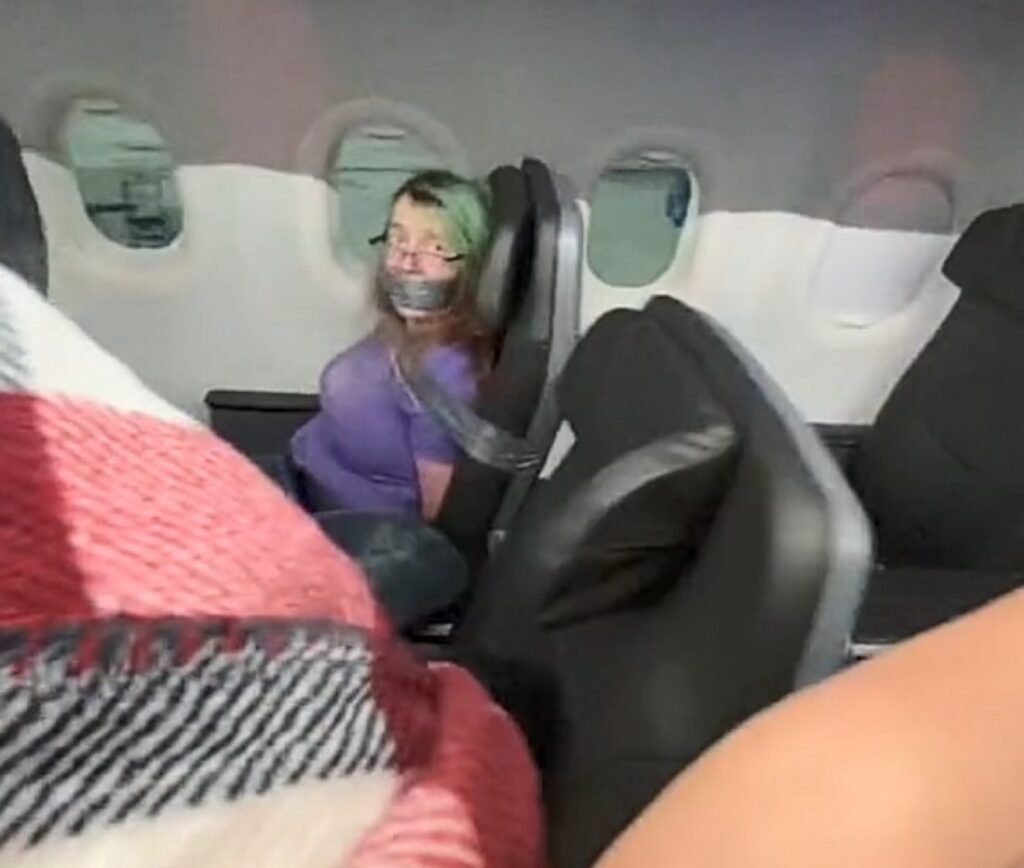Date: June 14, 2024
News Category: Airline Incident
Country: United States
Location: Between Dallas and Charlotte
In a disturbing incident aboard American Airlines Flight 1774, a mid-air emergency unfolded in July 2021 when Heather Wells, a passenger, tried to open the cabin door. The situation escalated rapidly as Wells, visibly disturbed, attacked flight attendants and was eventually restrained by being duct-taped to her seat. This incident, caught on social media, highlights the extreme measures sometimes necessary to ensure passenger safety and has led to significant legal and financial repercussions for Wells.

- The Outburst
- About an hour into the American Airlines Flight 1774 from Dallas to Charlotte, Heather Wells, seated in first class, exhibited increasingly erratic behavior. After consuming alcohol, she began shouting and acting aggressively towards passengers and crew.
- Escalation to Physical Confrontation
- Wells’s behavior escalated as she attempted to open the cabin door. When obstructed by flight attendants, she resorted to physical aggression, including biting and pushing a flight attendant aside in her attempt to access the door.
Crew Response and Passenger Safety
- Restraint and Safety Measures
- The situation required immediate action to ensure the safety of all aboard. Flight attendants, with no other immediate resources, restrained Wells using duct tape, securing her to her seat to prevent any further attempts to compromise the aircraft’s safety.
- Media and Public Perception
- Footage of Wells, duct-taped and shouting, was widely circulated on social media and news outlets, leading to a public debate over the appropriateness and safety of such restraint methods used in emergency situations on flights.
Legal and Regulatory Repercussions
- FAA Intervention
- In response to this severe incident, the FAA imposed a record fine of $81,950 on Wells, citing violations of several federal aviation regulations. This action underscores the FAA’s stance on maintaining strict safety protocols and dealing with unruly behavior on flights.
- Aftermath and Policy Implications
- The incident has prompted discussions within the airline industry about policies concerning the handling of unruly passengers, the need for additional training for flight crews, and the potential for non-lethal restraint tools that could be used in similar situations in the future.
Implementation of Restraint Techniques
- Assessment of Restraint Use
- The utilization of duct tape in this scenario, while unconventional, was a critical decision made under extreme circumstances. From a security standpoint, the priority was to prevent Wells from opening the cabin door, which would have endangered all aboard. This action, though drastic, underscores the need for better-equipped tools that can securely and humanely manage passengers who pose a threat.
- Ethical Considerations and Public Perception
- The public’s reaction to the incident was mixed, with many questioning the ethics of such restraint. The visual impact of seeing a passenger duct-taped raised significant concerns regarding passenger treatment. Security protocols must balance safety with ethical treatment, ensuring that all actions are defendable both legally and morally.
Crew and Passenger Safety
- Safety Protocols During High-Stress Incidents
- Ensuring the safety of all passengers and crew during a high-stress incident involves clear, practiced protocols that are regularly reviewed and updated. This incident highlights the necessity for continuous training in behavioral recognition and crisis management, crucial for preempting and managing such events.
- Communication and De-escalation Techniques
- Effective communication is vital. Crews should be trained in de-escalation techniques that could potentially calm the situation without resorting to physical restraints. Establishing a rapid and clear line of communication among crew members and with the cockpit is also essential for coordinating a cohesive response.
Post-Incident Analysis and Recommendations
- Review and Learning
- Post-incident analysis should be thorough, involving a step-by-step review of the event, the effectiveness of the response, and the decision-making process. Lessons learned should be integrated into future training programs to enhance the preparedness of the crew for handling similar situations.
- Development of New Guidelines
- This event calls for the development of new guidelines that focus on non-physical methods of intervention first and foremost, while also providing for the humane use of physical restraints as a last resort. The industry should consider the introduction of specialized equipment that is effective yet less intrusive and demeaning than duct tape.
The incident on American Airlines Flight 1774 serves as a significant case for reviewing and potentially revising airline security measures and crew training programs. The security field must continually evolve to address such challenges, ensuring that all measures taken are justifiable and focused on maintaining the highest safety standards without compromising the dignity of individuals involved. This balance is essential for sustaining public trust and confidence in airline safety protocols.

